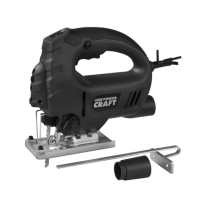Powercraft 09
• The laser beam shall not be deliberately aimed at personnel and shall be prevented from
being directed towards the eye of a person for longer than 0.25 s.
•
Always ensure the laser beam is aimed at a sturdy work piece without reflective surfaces.
i.e. wood or rough coated surfaces are acceptable. Bright shiny reflective sheet steel or the
like is not suitable for laser use as the reflective surface could direct the beam back at the
operator.
• Do not change the laser light assembly with a different type. Repairs must be carried out
by the laser manufacturer or an authorized agent.
CAUTION – Use of controls or adjustments or performance of procedures other
than those specified herein may result in hazardous radiation exposure.
WARNING – It may be difficult to see the laser in conditions of bright sunshine and
on certain surfaces.
Check that the switch is not interlocked in the ‘on’ position
Using the appliance
• Clamp the workpiece that you will be sawing in firmly into place.
• Remove any wood residue that is near or stuck to the surface of the saw blade; do not use
your hand for this. Switch the appliance off before removing any residue!
• Always switch the jigsaw on in idle, i.e. switch the jigsaw on before bringing it into contact
with the workpiece.
• When sawing the wood watch out for knots, nails, cracks and/or dirt deposits.
These can cause the saw blade to jam dangerously. Also watch out for this with waste
wood. This often requires less careful sawing, so there is a danger that you may not be
quite so careful about watching out for irregularities in the wood.
• Do not saw workpieces that are thicker than the length of the saw blade.
•
Do not touch metal parts of the jigsaw when sawing in walls or floors in which there could be
electricity cables. Hold the jigsaw tightly with both hands on the plastic grip so that you do
not touch parts that could become live if you accidentally saw through an electricity cable.
• When you have finished sawing, switch off the appliance first and wait until the saw blade
comes to a standstill before removing it from the workpiece.
• Do not use long extension cables.
• Keep the plastic guard in place while the jigsaw is in use.
Turn the appliance off immediatey in the event of:
• A faulty mains plug, mains flex or flex damage;
• A faulty switch;
• Sparking in the carbon brushes or ring fire in the commutator;
• Smoke or smell from scorched insulation.
Safety tips for the laser beamer
• Never look into the light beam of the laser.
• Never point the light beam of the laser at humans or animals.
• Do not point the light beam of the laser at strongly reflecting material. Hazard from
reflected light.
• Only have repairs made to the laser beamer by qualified personnel / professional repair
specialists.
GB
12 Powercraft
Dust-collection
Fig. 7
To keep the work surface clean, the jigsaw is equipped with a connection for dust extraction.
You can connect your vacuum cleaner to this. Use the vacuum cleaner adapter supplied for
this.
Guard
The jigsaw is fitted with a guard. Make sure that this guard is always mounted correctly while
the jigsaw is in use.
Laser beamer in use
The leading beam of the laser beamer makes sawing in straight lines much easier:
A. along a drawn line, or
B. by aligning it to a fixed point marked on the workpiece.
The range of the laser beam, depending on the environmental light, is about 65 cm.
Adjusting the laser beam
Fig. 10
Transport handling and heavy use can affect the precision of the laser beam:
• The laser beam itself can be easily adjusted.
• Hold the blade of the jigsaw against a straightedge or perfectly straight plank.
• Switch the laser on.
• Check whether the laser beam runs parallel along the edge of the straightedge or plank.
If the laser beam is out of alignment, proceed as follows:
• Loosen the 3 screws on the front side of the laser a few turns.
• Hold the blade of the jigsaw against a straightedge or perfectly straight plank.
• Correct the laser such that it runs dead straight along the edge.
• Again tighten the 3 screws.
Sawing
• Switch on the jigsaw.
• Place the bottom plate of the appliance on the workpiece.
• Move slowly towards the previously drawn sawing line and press the jigsaw forward
slowly.
Press the bottom plate firmly against the workpiece. If you do not do this the jigsaw is
likely to vibrate and the saw blade will break.
Let the jigsaw do the work. Do not press too hard on the jigsaw.
Parallel saw guide
Fig. 8
If you want to make a saw cut that runs parallel to the edge of the plank, use the parallel saw
guide supplied. You do this as follows:
• Loosen the socket head screws on the front of the bottom plate.
• Slide the parallel saw guide through the openings at the side of the bottom plate.
• Determine the distance between the saw cut and the side of the workpiece.
GB

